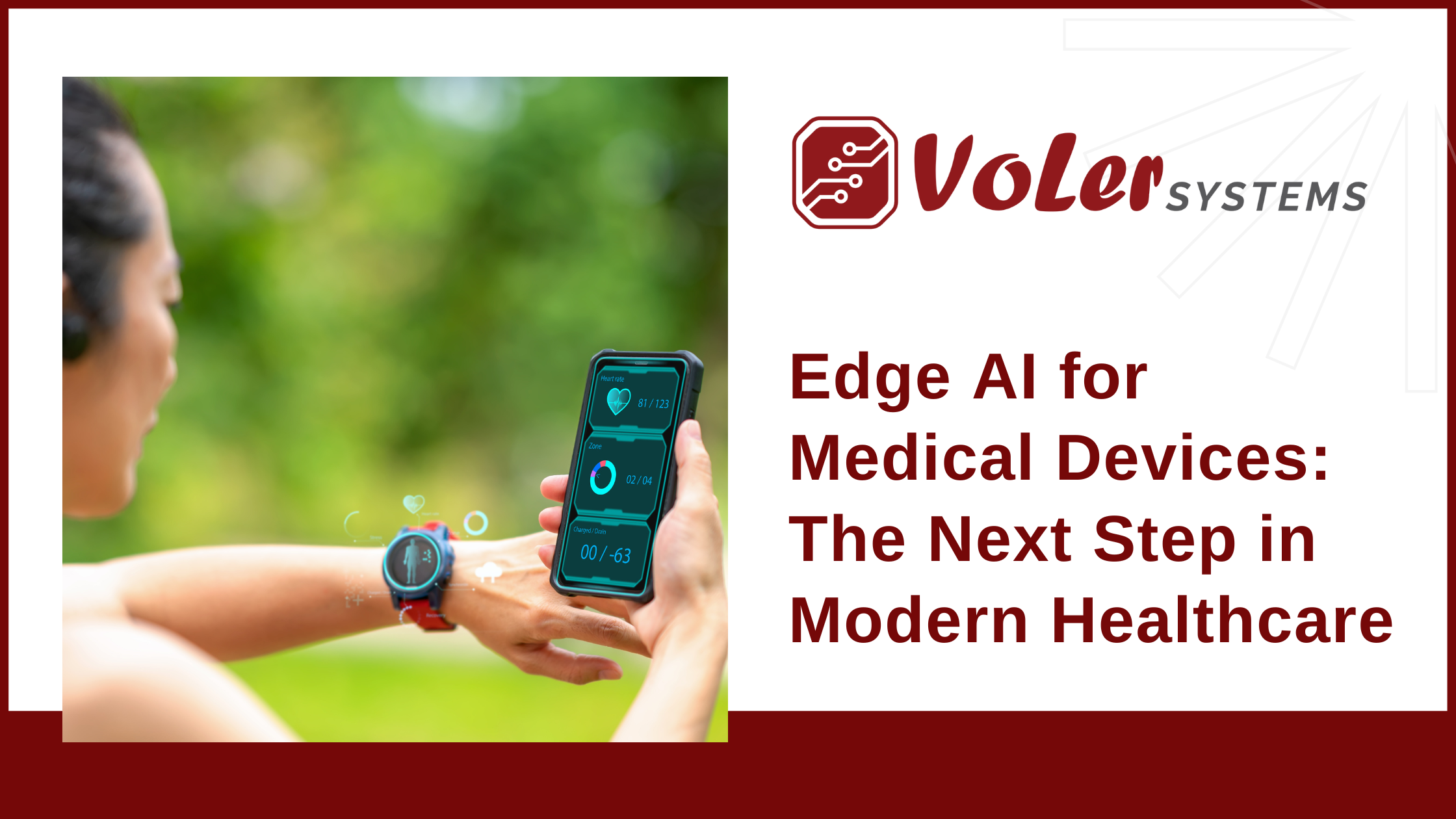Artificial Intelligence (AI) is revolutionizing healthcare, transforming it in unprecedented ways. This cutting-edge technology is making significant strides across the healthcare spectrum, from enhancing diagnostic accuracy to accelerating the pace of drug discovery.
Globally, AI in the healthcare market had a value of $22.45 billion at the end of 2023. But thanks to innovations and growing adoption, projections show the market surpassing $187 billion by the decade's end.
One of the most exciting facets of AI is edge AI, also known as "AI on the edge."
Thanks to state-of-the-art medical devices, the point of care is shifting. More and more patients receive monitoring, diagnoses, and treatment in their homes instead of a traditional hospital setting. Current medical devices are making that possible. But with edge AI for medical devices, we could see an even bigger shift that benefits patients and providers.
What is Edge AI?
Edge AI is the marriage of edge computing and artificial intelligence.
Edge computing is a distributed IT architecture that brings computation and storage closer to the data source. The massive growth and increasing power of IoT devices have created extraordinary volumes of data, so much so that it's outpacing network and cloud infrastructure capabilities. Edge computing aims to solve that problem, bringing data processing and analysis closer to the data's creation point.
Edge AI takes things even further, adding artificial intelligence and machine learning to the mix. With edge AI, data lives closer to devices, and AI algorithms can process it on the network edge without having to send it to a cloud facility or offsite data center.
AI can execute machine learning tasks directly on interconnected devices, with or without a strong internet connection. This results in ultra-fast data processing and real-time feedback.
How Does It Differ from Traditional AI for Edge Computing?
The biggest difference between traditional AI for edge computing and edge AI is where computations occur. Conventionally, generated data comes from connected devices before being transmitted to a cloud system. The cloud backend handles AI processing. AI modeling occurs far away from medical devices and relies on strong network connections to move data back and forth from the backend to the network edge.
That's not the case with edge AI. Edge AI is about deploying AI models directly onto local edge devices. Device makers can configure models onto processors within or near connected medical devices that operate on the network edge. So, not only does the medical device collect data, but it also processes and uses it.
The Growing Prevalence of Edge Computing in Medical Devices
Edge computing is not a new concept. Although the idea has existed since the 1990s, its true potential became evident only when medical devices and IoT technology became prevalent.
While networks are improving, future infrastructure will struggle to support the never-ending data transmission required for traditional AI.
Fortunately, several factors are fueling edge AI's emergence. These include:
- Advances in Compute Infrastructure: Cloud infrastructure is becoming more advanced every year, but innovations with smaller form factors in computing devices are making edge AI more and more viable.
- Advances in AI Technology: Artificial intelligence and its many branches continue to evolve. Improvements in neural networks, machine learning frameworks, platforms, and pre-trained models fuel edge AI growth.
- Advances in IoT Technology and Ecosystems: IoT ecosystems are evolving and expanding, particularly in the healthcare space. Ecosystems include more than just devices. They also include networks, cloud platforms, sensors and applications. Improvements across the board are facilitating more efficient exchanges of data and communication.
Types of Edge Intelligence
There are three primary types of edge intelligence.
- Cloud backend intelligence is currently the most prominent, but it will likely take a backseat as connected medical devices start to implement edge AI. This type refers to cloud systems that handle core compute and intelligence tasks.
Current cloud backends are responsible for data collection, model building and AI-ML deployment to edge devices. Medical devices collect metrics, but the backend processes them, requiring strong connectivity.
- Near-edge intelligence AI modeling occurs close to the device or data source. For example, patients might carry a wearable device that connects to a nearby data processing hub. This form of edge intelligence can facilitate remote patient monitoring, provide real-time surgery assistance, make clinical notes more accessible, etc.
- Far-edge intelligence shows the most promise and could reshape healthcare. In this case, data processing would occur on the device, offering in-device intelligence. Applications include wearables like smartwatches and rings or attachable/implantable sensors.
Near-edge and far-edge offer a more efficient alternative to cloud backend intelligence.
The Benefits of Edge AI for Medical Devices
The benefits of edge AI are plentiful, and experts in this technology have many reasons to implement it into medical devices.
- Real-Time Data Analysis, Insights and Decision Support
One of edge AI's biggest benefits is enabling real-time data processing. Traditionally, there's considerable latency as edge devices transmit information to the cloud backend. By taking the load off the cloud platform and moving processing and modeling tasks to the device, you get real-time information that could help with everything from diagnostics to monitoring.
Imagine how efficiency could improve with real-time data analysis. It can help with emergency room monitoring, alerting providers to issues quickly so that they can take action. It can even provide real-time decision support during medical procedures, preventing errors and allowing surgeons to gain instantaneous feedback.
- Lower Costs
Edge AI for medical devices can also substantially lower costs associated with gathering, transmitting and analyzing data. Data processes at a local level require less power than they do at cloud data centers.
Furthermore, sending data-heavy diagnostics imaged to the cloud for backend processing incurs more storage and compute expenses. Moving those tasks to the device can dramatically reduce bandwidth costs, improving accessibility.
- Enhanced Data Privacy, Security and Compliance
Privacy and security are always big concerns when dealing with medical data and protected health information (PHI). While cloud backends may use advanced encryption technologies, security events still occur. Because processing occurs on the edge device, you minimize the need to transmit PHI data.
It becomes easier to comply with HIPPA and other strict privacy regulations. Edge AI lowers the risk of mishandled or misappropriated data thanks to its local processing.
- Less Reliance on Quality Networks
Another significant benefit of edge AI is its low reliance on high-quality networks. Sending information to a cloud backend requires strong connectivity. However, not all patients have strong or reliable internet access.
That's a problem healthcare providers often face when providing remote healthcare to patients in rural areas. Edge AI requires little to no network connectivity. AI algorithms process the data with or without an internet connection, overcoming that hurdle and making edge intelligence possible from anywhere.
The Challenges of Implementing Edge AI in Medical Devices
Despite the many benefits of edge AI for medical devices, manufacturers and providers must overcome several implementation challenges.
- Data Privacy and Security: While the nature of edge AI makes it inherently more secure than using a cloud backend, vulnerabilities still exist. On-edge and near-edge devices are susceptible to physical theft and cyber attacks. Fortunately, there are solutions to mitigate risks, including encryption technology, security audits, etc.
- Regulatory Compliance: With emerging technologies comes new regulatory hurdles. Edge AI minimizes the need to transmit PHI data, but several regulatory concerns remain.
- Data Quality and Availability: Because edge AI enables quick data collection and processing, fewer quality control measures exist. Ensuring high-quality data and availability is paramount.
- Integration Complexities: Integrating edge AI into current and upcoming medical devices is a concern. Implementing the technology into evolving healthcare IoT ecosystems is also challenging.
- Clinical Validation and Explainability: Explainability is an important factor in AI and ML algorithms. One challenge is having edge AI describe its rationale for decision-making and how that impacts clinical validation.
- Cost and Multidisciplinary Expertise: Edge AI can lower overall costs by reducing bandwidth, but it creates newer costs in implementation and how professionals in different healthcare disciplines utilize it.
- Ethical Considerations: As with any technology that gathers personal information and utilizes AI, ethical concerns for edge AI exist. Those considerations are a hurdle manufacturers and providers must overcome.
- Liability and Legal Risks Liabilities and risks exist with any medical device.
The integration of edge AI creates new risks that manufacturers must overcome.
- User Acceptance and Resistance: There's always resistance to new technology, but that's especially true with anything that uses AI. Patients need education to understand and accept edge AI and its many capabilities.
Edge AI: The Future of Healthcare
Edge AI for medical devices represents a pivotal advancement in healthcare, offering transformative benefits like real-time data analysis, lower costs, enhanced privacy, and reduced dependence on network quality. As we navigate the complexities of integration and address ethical and regulatory challenges, the potential of edge AI to reshape healthcare is immense.
With its promise of more accessible, efficient, and effective medical care, edge AI stands at the forefront of a healthcare revolution, signaling an era where technology and medicine converge to improve patient outcomes and streamline healthcare delivery.

About Voler Systems
Voler Systems, based in the heart of Silicon Valley (Sunnyvale, California), specializes in designing and developing electronic devices for the medical, wearables, IoT, and consumer sectors. With a 44-year history of over 800 projects for over 400 clients, the company offers hardware, firmware, and software services. Voler's expertise includes sensors, wireless connectivity, power management, motion control, FPGAs, etc. Serving Fortune 500 companies, startups, and scaleups alike, Voler Systems delivers cost-effective and on-time solutions for organizations requiring device design and development support.
About V2Solutions
V2Solutions, established in 2003 in Santa Clara, California, is a renowned digital transformation partner serving over 400 organizations worldwide. As an ISO 9001-2015 certified and Great Place to Work recognized company, V2Solutions boasts a team of over 900 professionals across the U.S. and India, dedicated to delivering digital, cognitive technology, engineering, cloud, IoT, and customer experience solutions. Emphasizing a digital-first approach, V2Solutions strives for innovation and excellence, helping clients from startups to large enterprises achieve lasting digital transformation success.

